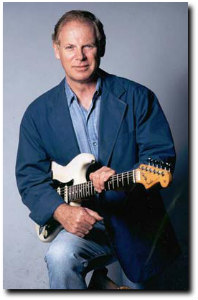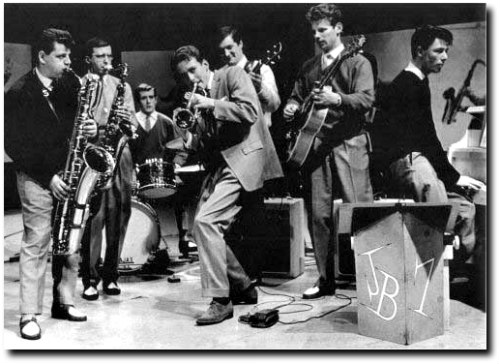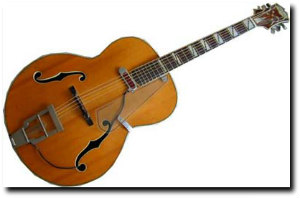
HOMEWesley Britton’s Books,
|
Spies on FilmSpies on Television & RadioSpies in History & LiteratureThe James Bond Files |
|
The James Bond Files ~ Spy Guitar – From
Vic Flick to Spy-Fi
By Wesley Britton Note ~ For more general information about spy music, refer to the file “Collecting TV Spy Music” in the Spies on Television & Radio section of this website. 
Musician Vic Flick strummed the famous “James Bond Theme” on his guitar in the first Bond movie Dr. No (1962). A trivia question – Do you know who played the first “air guitar,” the first dreamer to stand by a radio or record player imitating some long past inspiration? Answer – Curiously, according to Kevin Bochynski, a play by Mark Twain, “Is He Dead?” included a character named “Chicago” who is adept at playing imaginary instruments, one of which was the guitar. Possibly, it was a 19th-century writer (who also tried his hand at six-strings) who invented the concept of “air guitar” long before the advent of rock ‘n roll. Of course, Sam Clemens has nothing to do with spies. But guitar sounds certainly do. In the ‘60s, electrified strings helped shape the spy music genre from the 1961 British hit, “FBI” to the 1966 chart-topper, “Secret Agent Man” with the now-standard guitar hook created by American hitmakers, P.F. Sloane and Steve Barri. (Note 1) In 1967, guitars distinguished the themes to the film Our Man Flint and the follow-up to Secret Agent in Ron Grainer’s classic title music for television’s The Prisoner. Bass lines helped introduce the title melodies for I Spy, The Man From U.N.C.L.E., and The Wild Wild West. (Note 2) Much had changed since the first appearance of Sean Connery in that casino. In Goldfinger, Bond complained that the Beatles were best heard while wearing earmuffs. In Roger Moore’s debut in Live and Let Die, a Beatle, Paul McCartney, and a Beatle-producer, George Martin, gave 007 the musical bed, as it were, that made it clear popular music had much to do with the excitement, cultural impact, and merchandising of the world’s most famous secret agents. According to Thomas Pervanje, lead guitarist for the retro band Spy-Fi, all this was an outgrowth of classic film and television scores recorded before Dr. No. “By the time Bond came on the scene,” Thomas says, “Peter Gunn and Perry Mason had taken jazz and defined the crime jazz scene. Elmer Bernstein had written the score for The Man with the Golden Arm and there were other big movie and TV themes that helped support the genre. Nelson Riddle did the theme from Route 66. There was 77 Sunset Strip. Dragnet. Have Gun Will Travel.” According to Pervanje, “Henry Mancini was the first, that I know of, to popularize the guitar in the genre (and invented it as far as I’m concerned).” Session player Bob Bain, he noted, used a Telecaster on Peter Gunn. “When John Barry and Vic Flick got the call to finish the ‘James Bond Theme,’ the seeds had been sown. In fact,“ he added, “the John Barry Seven had a hit with ‘Walk Don’t Run’ as did the Ventures, so guitar was becoming an essential popular sound for orchestral music. The public was expecting it, so the composers worked it into the scores.” 
1959 – The John Barry Seven, with John Barry on the trumpet and Vic Flick on the guitar. At the dawn of the ‘60s, the signature “James Bond Theme” composed by Monty Norman for Dr. No as performed by legendary guitarist Vic Flick, was an unexpected phenomenon. In summer 2004, Vic told me how the best-known movie music came about. He happened to be the guitarist for the John Barry Seven when Barry got the nod to record the title music for the first Bond adventure. “After a 1958 European tour with Paul Anka, in which I was with another group, Barry asked me to join his band. I left circa 1963. John had left some two years before and put me in charge of the group. As my recording, TV and broadcasting work developed, I couldn’t find the time to leave town for concerts with the group and left.“ Before that, Vic said he never worked with composer Monty Norman, who scored all the Jamaican-flavored tunes for Dr. No. Regarding the “James Bond Theme,” which served as the title music for Dr. No, Vic recalls, “John Barry arranged the tune but the interpretation – if there is one – was kinda left to me.” The guitar was a Clifford Essex Paragon De Luxe, which will soon be on display at the Rock and Roll Hall of Fame. The Amp was a Vox 15. He noted the version using his sounds was used a few times in the films, for which he didn’t get paid. “I played on about the first five films and then intermittently. Last one being License to Kill with composer Michael Kamen.“ I asked if he thought the Bond musical style came together on From Russia with Love, one of the best soundtracks of the series. “I think the definitive ‘Bond’ sound started with Goldfinger, that is, apart from the original Bond Theme,“ he said. “Dr. No was such a rush job at the finish, no one had much thought to the future. But [producer Albert] Broccoli must have been thinking of a series because he wanted a strong theme and not the weak, bongo type music of Monty Norman.“ Was it the movement away from the island sounds you would hear on your family vacation? What made this 007 music so memorable? “There was a certain 60s sound,” Vic believes, “mainly obtained from the equipment used and the rawness of the music. The Bond theme had an energy that was a kinda one time thing that happened in the Studio – coupled with the ‘romance/excitement/get away from it all’ of the Fleming novels and their film treatment.” In later years, Vic’s work appeared in The Prisoner, The Return of the Pink Panther, “and others I mention in my ‘memoirs!’” (For which Vic is currently seeking a publisher.) Regarding The Prisoner, Vic recalls, “I got a call for a session at a film sound stage and it turned out to be music, including the theme, for The Prisoner. There were a couple more dates but can’t remember details.“ Gratefully, Flick has kept the 007 musical legacy alive, most recently in his 2000 James Bond Now CD on his own VF Records. On it, he plays instrumental versions of Goldfinger and Diamonds Are Forever. Bond fans will appreciate his versions of tunes he didn’t participate in for the original Roger Moore soundtracks including Live and Let Die, “Nobody Does It Better,“ and For Your Eyes Only. And, of course, he updates the opening strains of the James Bond theme. In addition, he adds his own spy-oriented compositions such as the “Shaken Not Stirred“ jam. (Note 3) One contemporary group Vic praises for also keeping the flame alive is Thomas Pervanje’s Spy-Fi. (Note 4) Founded in August of 1996 in Akron, Ohio, Spy-Fi has been performing surf, spy, and detective music at venues throughout Ohio and Los Angeles. Thanks to the Internet, they have fan clubs as far away as Belgium and Siberia. According to Vic Flick, “Spy-Fi plays those great songs from the ‘60s and ‘70s quite well. It all comes out like it’s supposed to be, spy music that is so atmospheric, so evocative.“ Reaching back to ‘60s surf band sounds like the pivotal Ventures, Spy-Fi CDs are indeed both faithful to the spirit of their inspirations and novel in their approaches in updatings of old melodies. I asked Thomas Pervanje what made the music of the Bond films so inspirational to him. “Bond is the perfect male romance novel,“ he replied. “Hey, he gets all the girls, blows stuff up, has cool toys, kills the bad guy and saves the world all in 90 minutes! What a concept! How could you not like this guy? And every time he’s introduced to the screen, this damn cool music is on that takes all of the great feelings of that world of crime jazz and elevates it to a new level. It became spy music. It had guitars, and it was powerful. It was an aural cattle brand on your brain. You never forgot it. It was world wide. It was the Coca-Cola of music. It didn’t matter what language you spoke; it tasted good and you wanted more.“ Of course, spy music was more than Bond. “After that, everyone wanted a drink from that fountain,” Pervanje adds. “Lalo Schiferen, Jerry Goldsmith et al. I am only now beginning to appreciate how cool and influential these guys were. And we all owe thanks to Leo Fender. He was the Henry Ford of guitar. Now that’s technology making the world a better place. Thanks, Leo; I miss you and I love your guitars. Bob Bain knew. Henry Mancini knew. Use a Fender Telecaster and you’ll create a most distinct sound for the hook. I never ever get tired of hearing it.“ 
Vic Flick’s guitar. To date, Spy-Fi – including Pervanje, Scott Anderson (keyboards), Bob Yeager (drums) and Mick Zofcin (bass) – have released two CDs of their tributes to such heroes. Volume One, Music for Spies, Thighs, and Private Eyes: The Thigh Who Loved Me (Silve Records, 2003) is indispensable for those loving this genre, opening with a rousing version of – what else? – the James Bond theme going into Goldfinger. For those familiar with the recordings of The Ventures, Spy-Fi’s energetic versions of “Secret Agent Man,” Batman, and The Man from U.N.C.L.E. will sound familiar. But improved, for my ears. Of course, the band is more than an on-stage machine of film and television melodies. For example, they put feeling into non-spy fare as in the re-working of the Ronnie Montrose version of “Town Without Pity.” (Note 5) For my money, Volume Two, aka Music for Spies, Thighs, and Private Eyes: Mr. Kiss Kiss Bang Bang (Silve Records, 2003) is quite listenable although the energy level seems toned down from the debut disc. But unexpected pleasures pop up including unique medleys like Dragnet blending into the “007 Theme.” And The Munsters segued into the theme to Hawaii Five-O. On this disc, old spies return in the themes to Get Smart and Mission: Impossible. As of this writing (summer, 2004), Spy-Fi is working on their third CD of even more spy/detective music along with original tunes that express the reverence the group has for the musical forms that transcend generations. Presently, both volumes of their music can be purchased together for the price of one. While not yet appearing on the same stage, Spy-Fi and Vic Flick perform regularly for live audiences, so watchful fans might well be able to both catch these players in person and say hello. Until then, don’t pass up your chance to either take a dip into nostalgia or create new aural memories – at the very least, you can join the tradition started by Mark Twain. Photographs courtesy of Vic Flick. February 2005 Updates ~ Our buddies in the ‘60s retro band Spy-Fi keep on getting rave reviews for their first two CDs! The newest accolades from the British magazine Pipeline can be read on their site, Pipeline: The Rock Instrument Review. Here’s a note about Vic Flick’s guitar on display at the Rock ‘n’ Roll Hall of Fame Museum. Notes ~ Note 1 – You can find “FBI” on the CD The Shadows Are Go! on Scamp Records. According to Johnny Rivers’ website, the guitar used for the famous live version of “Secret Agent Man” was a red Gibson 335. Rivers said he recorded the Live at the Whiskey A Go Go album in two nights using borrowed equipment. It took time for the album and its most famous hit to be issued. At first, no record companies wanted it. Note 2 – According to I Spy composer Earl Hagen, “The guitar on the main title to I Spy was Alan Reuss. My old buddy from the Benny Goodman Band. I don’t know what kind of electric guitar Alan used. I think it was Cliff Hils on bass guitar.” For Hagen’s comments on the spy music genre, refer to the file “Collecting TV Spy Music” in the Spies on Television & Radio section of this website. Note 3 – For more information about Vic and purchasing his CD, refer to his blog Vic Flick. View a video clip of Vic Flick with the John Barry Seven in 1960, and a present day interview about his Bond guitar work, on YouTube. Note 4 – An interesting question is just when did the term “Spy-Fi” originate? As reported elsewhere at this site, and in my book Spy Television (Praeger, 2004), scriptwriter Danny Biederman is widely credited with coining the idea. Thomas Pervanje says Scott Anderson, Spy-Fi’s keyboard player, came up with the name in the fall of 1996. “I really don’t know where he got it from, or just made it up. He’s a clever guy, and we decided to snag the spy-fi.com domain name a bit after that. It turned out to be a prudent move. I have received emails from the Omega Men, which seems to claim that they came up with it.” “Agent XKE” wrote Pervanje – “Almost 10 years ago, some agents made up an off the cuff response to satisfy the inquisitors. The answer was ‘SPY_FI.’ We never thought it would enter the vernacular. But so it came to pass.” Thomas adds, “I have learned that in 1993 there was a poster that had the term Spy-Fi on it. It was for a spy convention that had Lois Maxwell attending. At that time there was a reggae group who cut a single called ‘spy fi die’, which talks about a detective or spy.” Note 5 – To learn about Spy-Fi’s public gigs and other information, visit the band’s web site at Spy-Fi International Headquarters. Or to check out reviews of the double CD set, including order information, visit ~
HammondBeat:
The Official Funk and Groove Website
|